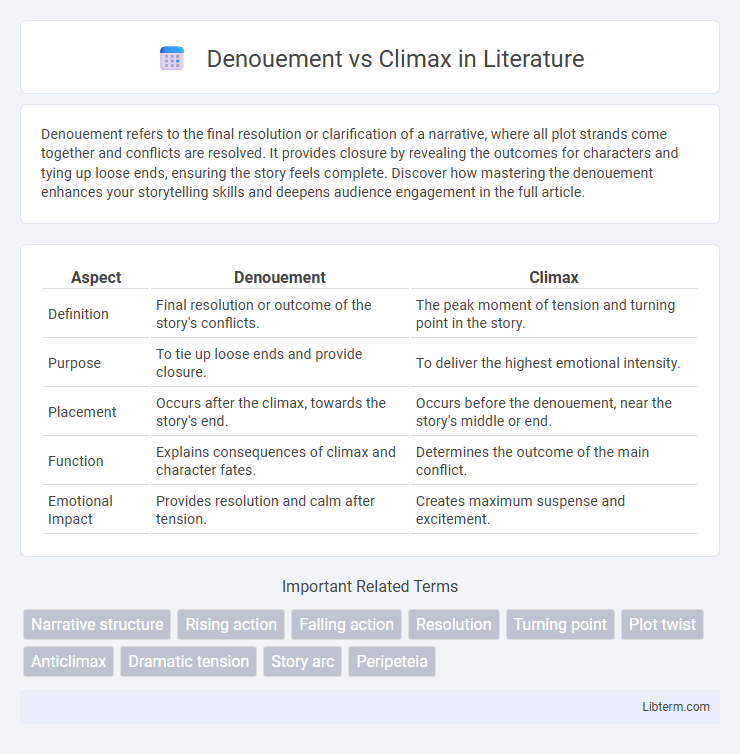Denouement refers to the final resolution or clarification of a narrative, where all plot strands come together and conflicts are resolved. It provides closure by revealing the outcomes for characters and tying up loose ends, ensuring the story feels complete. Discover how mastering the denouement enhances your storytelling skills and deepens audience engagement in the full article.
Table of Comparison
| Aspect | Denouement | Climax |
|---|---|---|
| Definition | Final resolution or outcome of the story's conflicts. | The peak moment of tension and turning point in the story. |
| Purpose | To tie up loose ends and provide closure. | To deliver the highest emotional intensity. |
| Placement | Occurs after the climax, towards the story's end. | Occurs before the denouement, near the story's middle or end. |
| Function | Explains consequences of climax and character fates. | Determines the outcome of the main conflict. |
| Emotional Impact | Provides resolution and calm after tension. | Creates maximum suspense and excitement. |
Understanding Climax and Denouement
The climax represents the highest point of tension or conflict in a narrative, often marking a decisive confrontation or turning point that determines the story's outcome. The denouement follows the climax, providing resolution by unraveling plot complications and revealing the consequences of the protagonist's choices. Understanding the distinction between climax and denouement is crucial for analyzing narrative structure and the emotional pacing of a story.
Defining the Climax in Narrative Structure
The climax in narrative structure represents the moment of highest tension and conflict, where the protagonist faces their greatest challenge or makes a pivotal decision that determines the story's direction. It is the turning point that propels the narrative toward resolution, often marked by intense emotional or dramatic impact. Unlike the denouement, which follows and ties up loose ends, the climax is the critical peak that defines the story's core conflict and stakes.
What is a Denouement?
A denouement is the final part of a narrative where strands of the plot are tied up and conflicts are resolved, providing closure to the story. It follows the climax, the story's peak of tension or turning point, and reveals the consequences of the climax's events. In literature and film, the denouement clarifies character fates, answers lingering questions, and establishes the story's final tone or message.
Key Differences Between Climax and Denouement
The climax is the story's highest point of tension where the main conflict reaches its peak, often delivering a decisive confrontation or turning point. In contrast, the denouement unfolds after the climax, providing resolution by tying up loose ends and revealing the outcomes for characters and plotlines. Key differences include the climax driving the narrative's critical conflict, whereas the denouement emphasizes closure and the final consequences post-conflict.
Importance of Climax in Storytelling
The climax serves as the pivotal turning point in storytelling, where the main conflict reaches its highest intensity and the protagonist faces their greatest challenge. This moment drives emotional engagement and sets up the resolution, making it crucial for maintaining narrative momentum. A strong climax ensures that the story's themes and stakes resonate deeply with the audience, leading to a satisfying denouement.
Role of Denouement in Narrative Resolution
The denouement serves as the crucial phase in narrative resolution, where conflicts introduced during the climax are unraveled and loose ends are tied up, providing clarity and closure to the story. Unlike the climax, which represents the peak of tension and decisive action, the denouement allows for reflection and understanding of the consequences of the climax's events. This phase solidifies the narrative's thematic messages and character development, ensuring a satisfying and coherent conclusion for the audience.
Examples of Climax and Denouement in Literature
In Shakespeare's *Macbeth*, the climax occurs when Macbeth faces Macduff in a final battle, marking the story's peak tension and conflict. The denouement follows as Malcolm restores order to Scotland, resolving the chaos unleashed by Macbeth's tyranny. Similarly, in *Harry Potter and the Deathly Hallows*, the climax unfolds during the Battle of Hogwarts with Harry confronting Voldemort, and the denouement reveals the characters' futures and the world rebuilding after the war.
Common Misconceptions: Climax vs. Denouement
The climax is mistakenly believed to be the story's end, but it actually represents the peak of tension where the main conflict reaches its turning point. The denouement follows the climax, serving as the resolution phase where loose ends are tied up and character arcs conclude. Confusing these stages can lead to misunderstandings about narrative structure and story pacing.
How to Write an Effective Climax and Denouement
Craft an effective climax by heightening conflict intensity and emotional stakes, ensuring the protagonist faces their greatest challenge and critical decisions to maintain reader engagement. The denouement resolves remaining plot threads, providing clarity and emotional closure without dragging the narrative. Emphasize pacing transitions carefully to shift from peak tension in the climax to satisfying resolution in the denouement.
Analyzing Climax and Denouement in Popular Films
The climax in popular films represents the peak of tension and conflict, where protagonists face their greatest challenges, such as in "The Dark Knight" when Batman confronts the Joker. The denouement follows, providing resolution and tying up narrative threads, like the final scenes of "The Lord of the Rings: The Return of the King" that restore order and closure. Analyzing these elements reveals how filmmakers balance suspense with satisfaction to enhance audience engagement and emotional payoff.
Denouement Infographic

 libterm.com
libterm.com